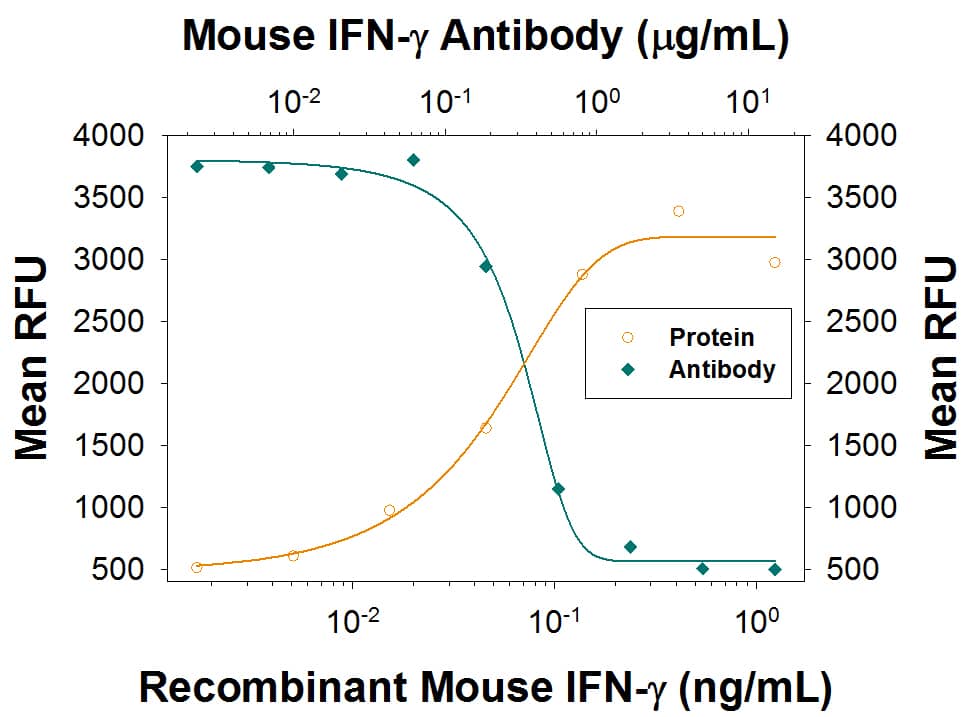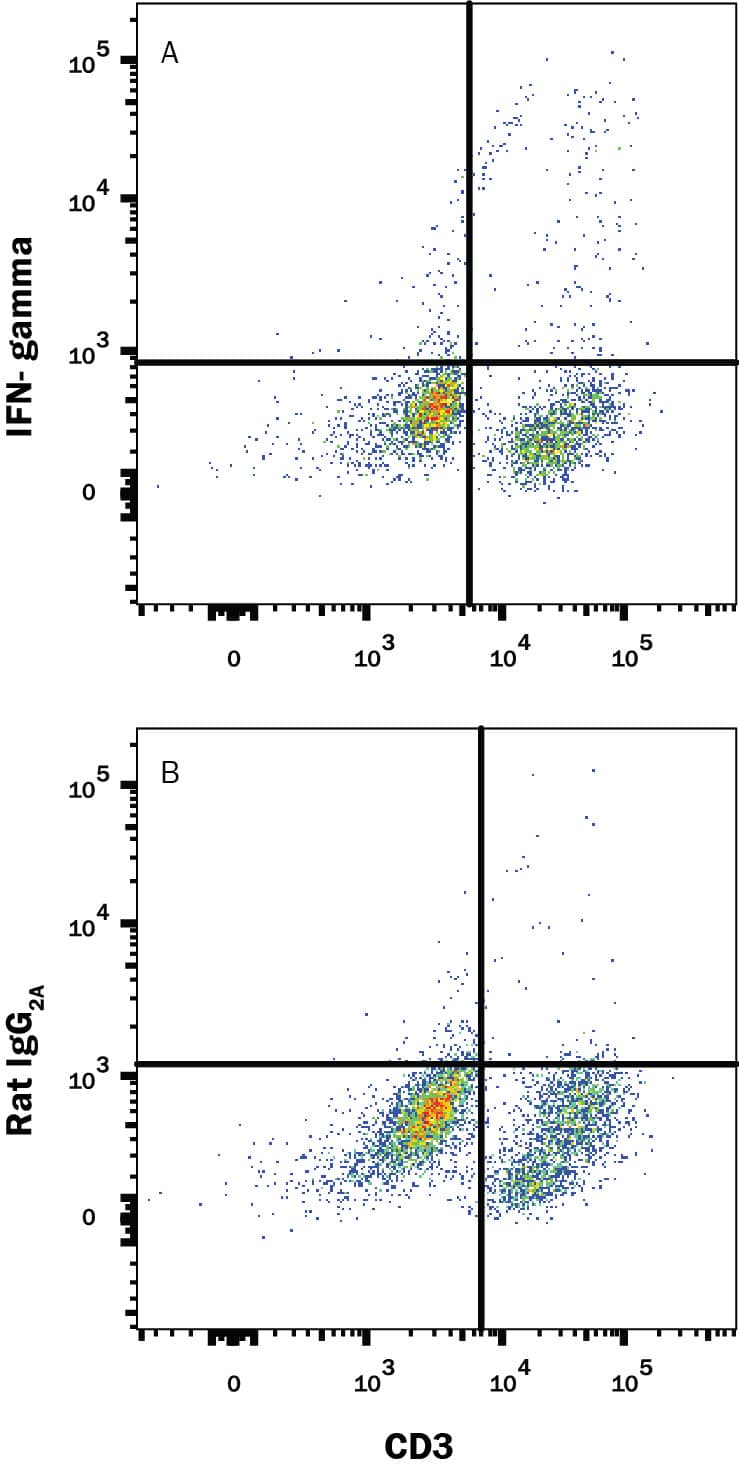Mouse IFN-gamma Antibody
R&D Systems, part of Bio-Techne | Catalog # MAB485R
Recombinant Monoclonal Antibody.


Conjugate
Catalog #
Key Product Details
Species Reactivity
Validated:
Mouse
Cited:
Mouse
Applications
Validated:
Intracellular Staining by Flow Cytometry, Neutralization
Cited:
Western Blot
Label
Unconjugated
Antibody Source
Recombinant Monoclonal Rat IgG2A Clone # 37895R
Product Specifications
Immunogen
E. coli-derived recombinant mouse IFN-gamma
Specificity
Detects mouse IFN-gamma in Western blots. In Western blots, this antibody does not cross-react with rhIFN‑ gamma, rrIFN‑ gamma, rpIFN‑ gamma, rrmIFN‑ gamma, rfeIFN‑ gamma, or rcaIFN‑ gamma.
Clonality
Monoclonal
Host
Rat
Isotype
IgG2A
Endotoxin Level
<0.10 EU per 1 μg of the antibody by the LAL method.
Scientific Data Images for Mouse IFN-gamma Antibody
IFN-gamma Inhibition of EMCV-induced Cytopathy and Neutralization by Mouse IFN-gamma Antibody.
Recombinant Mouse IFN-gamma (Catalog # 485-MI) reduces the Encephalomyocarditis Virus (EMCV)-induced cytopathy in the L-929 mouse fibroblast cell line in a dose-dependent manner (orange line), as measured by Resazurin (Catalog # AR002). Inhibition of EMCV activity elicited by Recombinant Mouse IFN-gamma (1.5 ng/mL) is neutralized (green line) by increasing concentrations of Mouse IFN-gamma Monoclonal Antibody (Catalog # MAB485R). The ND50 is typically 0.075-0.3 µg/mL.Detection of IFN‑ gamma in Mouse Splenocytes by Flow Cytometry.
Mouse splenocytes were stained with Rat Anti-Mouse CD28 Alexa Fluor® 488-conjugated Monoclonal Antibody (Catalog # FAB4832G) and either (A) Rat Anti-Mouse IFN-gamma Monoclonal Antibody (Catalog # MAB485R) or (B) Rat IgG2AIsotype Control (Catalog # MAB006) followed by Phycoerythrin-conjugated Anti-Rat IgG Secondary Antibody (Catalog # F0105B). To facilitate intracellular staining, cells were fixed with Flow Cytometry Fixation Buffer (Catalog # FC004) and permeabilized with Flow Cytometry Permeabilization/Wash Buffer I (Catalog # FC005). View our protocol for Staining Intracellular Molecules.Applications for Mouse IFN-gamma Antibody
Application
Recommended Usage
Intracellular Staining by Flow Cytometry
0.25 µg/106 cells
Sample: Mouse splenocytes were fixed with Flow Cytometry Fixation Buffer (Catalog # FC004) and permeabilized with Flow Cytometry Permeabilization/Wash Buffer I (Catalog # FC005)
Sample: Mouse splenocytes were fixed with Flow Cytometry Fixation Buffer (Catalog # FC004) and permeabilized with Flow Cytometry Permeabilization/Wash Buffer I (Catalog # FC005)
Neutralization
Measured by its ability to neutralize IFN‑ gamma inhibition of EMCV-induced
cytopathy in the L‑929 mouse fibroblast cell line. Vogel, S. and M.
Hogan (1995) in Current Protocols in Immunology. Ciocio, R. (ed); John
Wiley & Sons, Inc. p. 6. 9. 1. The Neutralization Dose (ND50) is typically 0.075-0.3 µg/mL in the presence of 1.5 ng/mL Recombinant Mouse IFN‑ gamma.
Formulation, Preparation, and Storage
Purification
Protein A or G purified from cell culture supernatant
Reconstitution
Reconstitute at 0.5
mg/mL in sterile PBS.
For liquid material, refer to CoA for concentration.
Formulation
Lyophilized from a 0.2 μm filtered solution in PBS with Trehalose. *Small pack size (SP) is supplied either lyophilized or as a 0.2 µm filtered solution in PBS.
Shipping
Lyophilized product is shipped at ambient temperature. Liquid small pack size (-SP) is shipped with polar packs. Upon receipt, store immediately at the temperature recommended below.
Stability & Storage
Use a manual defrost freezer and avoid repeated freeze-thaw cycles.
- 12 months from date of receipt, -20 to -70 °C as supplied.
- 1 month, 2 to 8 °C under sterile conditions after reconstitution.
- 6 months, -20 to -70 °C under sterile conditions after reconstitution.
Background: IFN-gamma
Long Name
Interferon gamma
Alternate Names
IFG, IFI, IFNG, IFNgamma
Entrez Gene IDs
Gene Symbol
IFNG
Additional IFN-gamma Products
Product Documents for Mouse IFN-gamma Antibody
Product Specific Notices for Mouse IFN-gamma Antibody
For research use only
